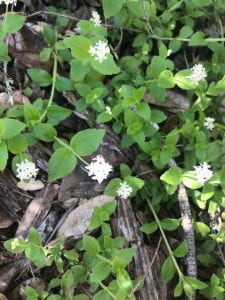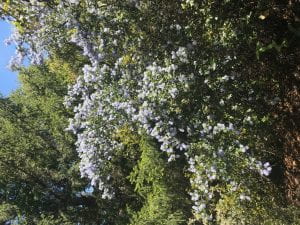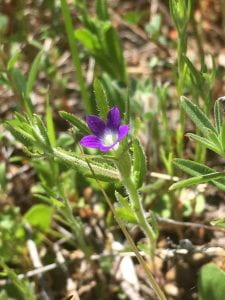Mt. Tamalpais, CA
Coordinates: 37 °54’267 N 122 °29’40″W
Mt.Tamalpais is a peak in Marin County, California, often considered symbolic of Marin County. There were beautiful views and plant species on the way drive up. It was the highest place we’d been this semester. The place was full of coastal scrub, grassland, redwood forests and interestingly serpentine soil. There were some species living in the rocky serpentine output. For example, Claytonia exiqua is one of the special species that can thrive in that harsh environment. This species might not do well in other environment such as clay soil compared to other species. The mountain also provide home for many wildlife animals such as lizards, birds, and snakes.
Leptosiphon parviflorus
Leptosiphon parviflorus is a annual plant that is part of Polemoniaceae. The stem range from 4 to 40cm and the narrowly obovate to linear leaves consists of lobes 2-19mm. The inflorescence is head, and the flowers are closing at night. The flower is densely hairy, glandular, membrane obscure. The tube is 11-46mm, elliptic to oblanceolate, thread-like and colors of pink, white, or yellow. It mostly lives in open or wooded areas about less than 1200m elevation. The flowering time is between March to June.
Whipplea modesta
Whipplea modesta, also known as modesty, is a part of family Hydrangeaceae. It is a native plant that is perennial herb. The ovate to elliptic leaves are persistent, blade about 1.5-4cm, 1-3cm wide, coarsely strigose, and ascending upper surface hairs. The inflorescence is cyme or raceme, and have flowers about 4-12. The flower is about 4-6mm wide, and consists of 4-6 narrowly oblong sepals about 1.5-2mm, obovate white petals about 4-6. It has terminal stigma and doesn’t have any smell. It mostly lives in coastal scrub, chaparral, forest, or open areas about 45 to 1525m elevation. The flowering time is in between March to July.
Ceanothus cuneatus
Ceanothus cuneatus, also known as Buckbrush, is a native flowering shrub that is part of the Rhamnaceae family. It is every common in California and known for its evergreen leaves that is opposite and sessile. The stem is generally ascending to spreading, twigs generally gray to brown. The leaves are some occasionally clustered, blade elliptic, oblanceolate, or obovate. The flower is generally white or light blue. It lives in sandy to rocky flats, slopes and ridges about less than 2133m elevation. The flowering time is in between February to May.
Mysterious Plants!
Githopsis specularioides, Common bluecup
Viola pedunculata, California golden violet
Narrative: We left the campus around 1pm and the weather was cloudy, and chilly. I thought it would not be a good day for hiking, but surprisingly when we arrive at the peak of the mountain, it became extremely hot and dry. I thought I would not need a water but it was a big mistake. I was so dehydrated until we found the water fountain. We started walking from the serpentine output where some special plants thrive in such a harsh environment. However they would not survive in other places since their competitive ability is really poor compared to other plants. We could see the downtown at the peak and realized how all the clouds are clustered under to city while we have beautiful sunshine up here at the mountain. The hike is overall great, not too difficult. The most interesting thing was I got to see the plants that live in serpentine soil in person and the snakes!!
Additional photos
Allium falcifolium – Sickle leaf onion
Wyethia angustifolia, part of Asteraceae
Allium falcifolium, sickle leaf onion, part of Amaryllidaceae
Phacelia distans, part of Boraginaceae








